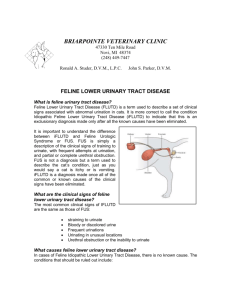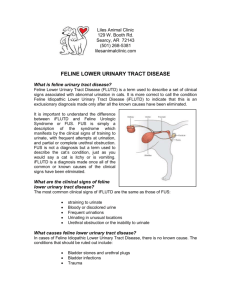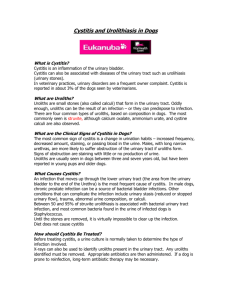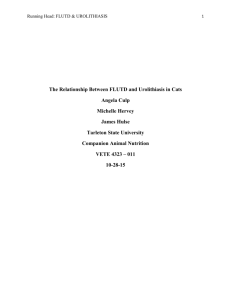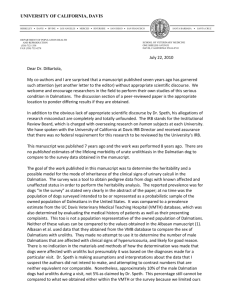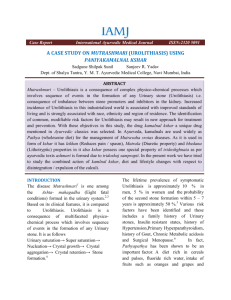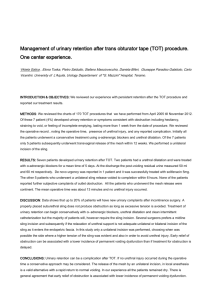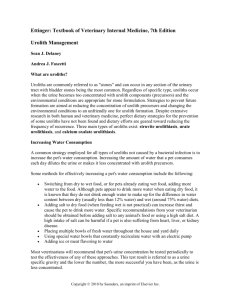Diseases of the Urinary System
advertisement
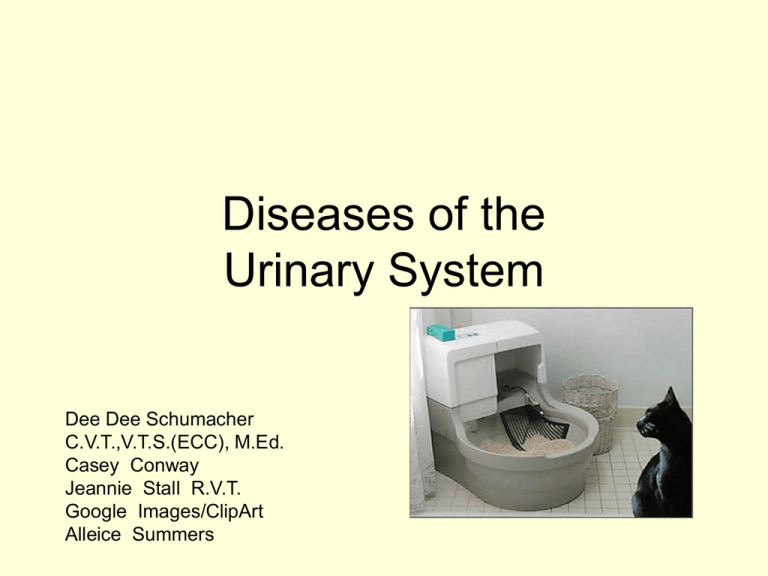
Diseases of the Urinary System Dee Dee Schumacher C.V.T.,V.T.S.(ECC), M.Ed. Casey Conway Jeannie Stall R.V.T. Google Images/ClipArt Alleice Summers Feline Lower Urinary Tract Disease (FLUTD) • AKA feline cystitis, FUS • Cause : Unknown • Appears to be self-limiting in most cats (according to book) • Symptoms: Hematuria, > frequent urinations Dysuria (painful urination),Inappropriate urination • Dx: U/A, urine culture, x-rays • Tx: Only use abx if necessary, change diet, use antiinflammatory meds w/ caution • May be recurring problem, there is no definitive cure Canine Cystitis • Bacterial urinary tract infection is the most common cause • Symptoms: Increased frequency of urination, Hematuria, Dysuria, Frequent licking of the urethral area • Dx: U/A , urine culture • Tx: abx based on culture & sensitivity, Acute – tx for 10-14 days Chronic- tx for 4-6 weeks • Relapses are common due to inadequate treatment Feline Uroliths Multi-crystalline concretions composed of minerals w/ a sm. amt. of matrix ( mucoprotein ) AKA “bladder stones” (may be located anywhere in the urinary tract) • Radiopaque or radiolucent • Obese, older cats appear to be predisposed • Small uroliths can become lodged in the urethra (obstruction) Symptoms depend on degree of trauma, obstruction – – – – – – – Hematuria Dysuria Inappropriate urination Straining to pass urine Vomiting Collapse Death • May be asymptomatic Feline Uroliths • Dx: x-rays, ultrasound, PE • Tx: diet that alters urine pH and dissolves uroliths for 4-8 weeks, abx • Surgical treatment – cystotomy, uroliths Obstruction – must unblock urethra asap, supportive therapy PU (perineal urethrostomy): If uroliths can’t be removed from urethra Feline Urethral Plugs • Consist of small, varying amts. of minerals w/ large amt. of matrix( mucoproteins) Same factors associated w/ formation of uroliths • Symptoms: – – – – Straining to urinate Vomiting Dehydration Collapse • Dx: bladder is enlarged & firm on palpation, hx, x-rays, bloodworkincreased BUN, CREA, Phos. levels Feline Urethral Plugs • Must reestablish urethral patency asap! • In azotemic cats, less anesthesia is necessary • Do not perform cystocentesis until unblocked! Urolithiasis - Canine • Studies indicate prevalence < 1% in dogs • Uroliths form in urine supersaturated with specific substances – minerals • After formation – may pass out urinary tract, continue to grow in the tract, dissolve, or become inactive • Clin.signs: Dysuria, hematuria Urolithiasis - Canine • Dx: u/a, x-rays, labwork, stone analysis • Tx: change diet, abx, surgical removal, urohydropropulsion Urolithiasis - Canine Renal Failure • Filtration & waste management of the body • Reduction in blood flow or damage to the nephron results in renal failure – acute or chronic Nephron unit is damaged & glomerular filtration declines, resulting in azotemia (build-up of toxins in body) • Clin. Signs: Acute – oliguria, polyuria, fever, kidneys painful on palpation, v/d, anorexia, dehydration • Dx: Phys. exam, Hx, U/A, blood work • Tx: IV fluids, discontinue nephrotoxic drugs, intestinal protectants, diuretics • May improve renal function, it may never return to completely normal levels, prognosis can be guarded Chronic Renal Failure Common in older pets, irreversible & progressive decline in renal function, months to years • Cats more affected than dogs • Clin.signs: Dullness, lethargy, weakness, wt. loss, anorexia, v/d, polyuria, polydipsia, gait disturbances in cats, sudden blindness Chronic Renal Failure • Dx: labwork • Tx: Supportive care & correction of imbalances-dehydration, electrolytes, GI symptoms • IV or SQ fluids, diuretics, consider euthanasia ??? Urinary Incontinence • Frequent in older pets • Loss of voluntary control of urination • Multiple causes: Neurologic, obstruction, bladder disease, hormone levels • Clin. Signs: Owner reports pet “leaks” when asleep or exercising, perianal area is always wet • Signs of concurrent UTI are present • Older ,SF, intact males predisposed • Dx: u/a, x-rays, bloodwork • Tx: based on determination of specific cause • Phenypropanolamine (PPA) Equine • Cystitis – inflammation of the bladder, rare, dx same, tx same • Urinary bladder prolapse – postpartum mares, replace bladder, avoid rupture, abx • Incontinence – diff to treat, tx is usually symptomatic, urine scald • Urolithiasis – rarely cause obstruction, if do- male horse, removal Urolithiasis – Sheep & Goats • Most commonly seen in wethers, rams, bucks that are on high-concentrate diets • Common in feedlot & pet animals • Similar clin. signs • Dx: clin. signs, u/a, x-rays • Tx: Amputate urethral process, cystotomy, urinary acidifiers CALCIUM OXYLATE CRYSTALS STRUVITE (TRIPLE PHOS.) CRYSTALS
